

Turkish Ottoman Navy vs Royal Navy
The end of the Ottoman fleet
Before the Autro-Hungarian Navy was condemned to inaction a few monthes afterwards in june with the sinking of the Szent Istvan, the fate of the Turkish Ottoman fleet was decided in January 1918, not by the Russians, but by the British Navy. As a reminder, the old Ottoman Navy was unexpectedly reinforced in August 1914 by two fleeing state-of-the-art German warships: The Goeben, a Moltke-class battlecruiser (1912) and the Breslau, an equally modern light cruiser of the 1912 Magdeburg class. They were renamed Yavuz Sultan Selim and Midilli repectively and remained a constant threat for the Russian Navy in the black sea, as well. However, the Russian revolution changed the situation, and now the Ottoman Navy had free hands to intervene against allied assets in the eastern Mediterranean at any moment.
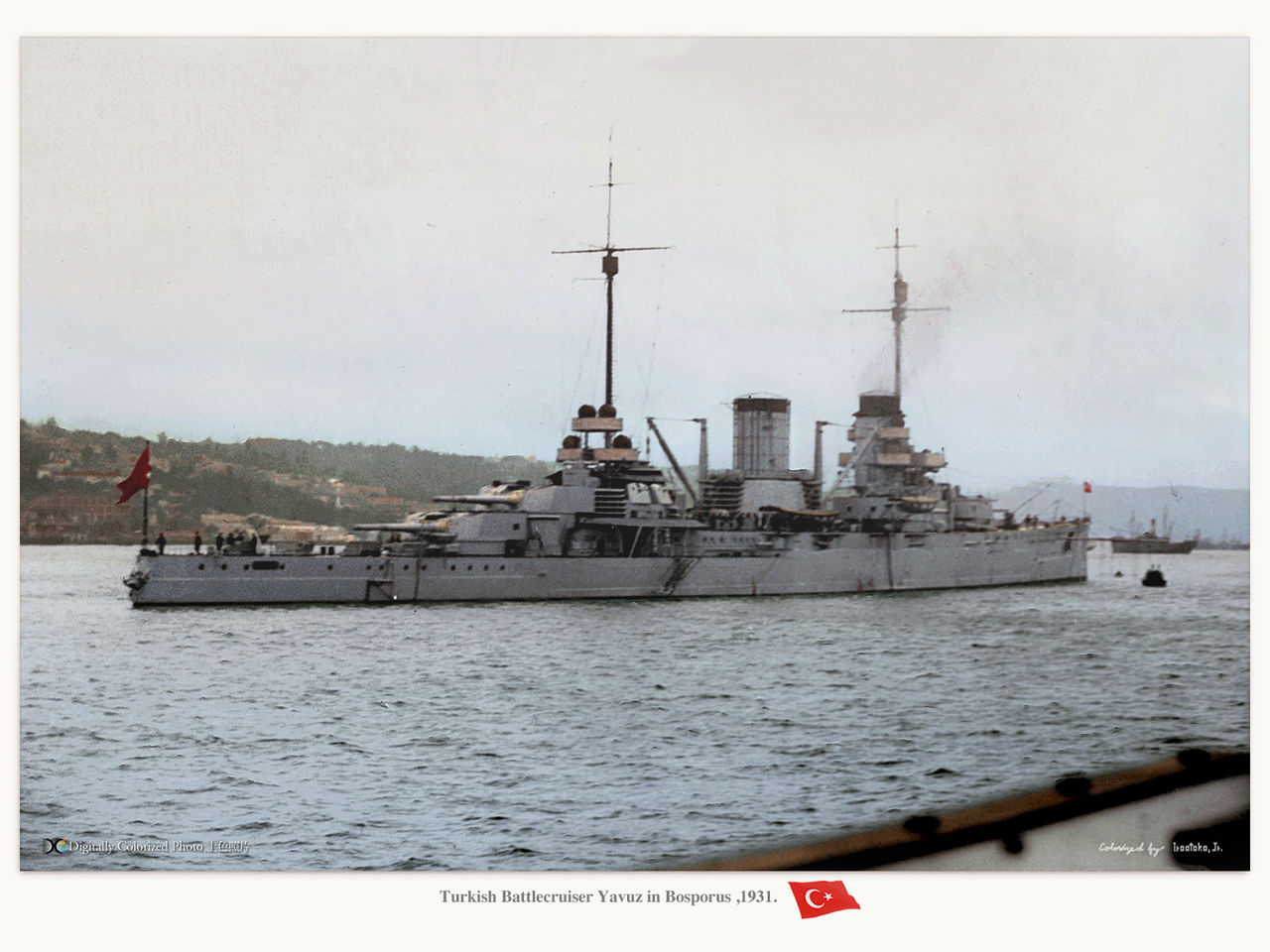
Battleship Yavuz in the Bosporus. Colorized photo by hirootoko jr. By far the most serious asset of the Turkish Ottoman navy since 1914
Strategic situation in the Aegean
At that time, the Balkan war pitted the allied armies, included the Greeks, against a coalition of Bulgarians and German troops while the Turks Ottoman Army in Palestine was in disarray, with British troops advancing steadily. The British Navy stationed in the Aegean Islands covered shipping and reinforcements to the whole area, and provided naval support with the heavy guns of monitors and other ships, close to the coast. The German commander of the Ottoman Black Sea fleet, Rebeur Paschwitz, which had these two precious ships manned by compatriots at his disposal, was thinking to relieve the pressure by taking on the Royal Navy assets there, not able to counter the German ships.
The Ottoman naval raid would include an attack on the british ships anchored at Kusu Bay off the islands of Imbros. Paschwitz would then turn the squadron against shipping and the local British naval base. Another decisive factor was at that time, that the allied squadron guarding the Dardanelles was weakened by the absence of the pre-dreadnough battleship HMS Lord Nelson, leaving just the HMS Agamemnon and a few destroyer to cover the sector.
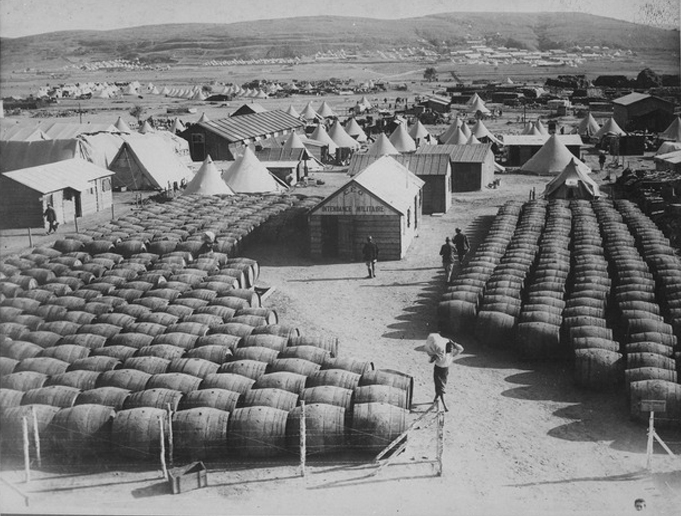
Mudros Camp
Respective Forces
Outside the HMS Agamenon anchored off Mudros, which had only four 305 mm guns versus ten faster 280 mm for the Yavuz (and was much slower), the British squadron also comprised the monitors HMS Raglan and M28, and the Acheron-class destroyers HMS Tigress and HMS Lizard which could be dealt with by the Midilli, flanking the Yavuz in the operation. Perhaps the Raglan, an Abercrombie-class monitor, was more seriously taken by the German head of staff, bearing with two 14-inch guns. However its fire controls were optimized for coastal bombardment, and she was slow and not well protected.
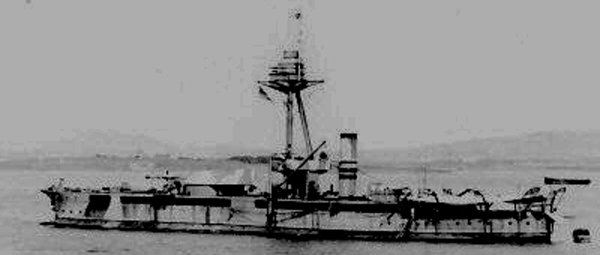

Monitor HMS Raglan, Abercrombie class (top: in 1915, bottom, leaving Malta for Brindisi – Imperial War Museum coll.
Attack on Imbros
On 20 January 1918 en route to Imbros, Yavûz Sultân Selîm struck a mine, but the damage was light. It was decided both ship would resume their advance and complete their mission. When in sight, Yavûz shelled the British signal station at Kephalo Point to cut out transmissions and prevent reinforcements. Midilli sailed to the entrance of Kusu Bay. Both ships then joined to approach Kusu Bay at 5:30 am. They spotted the destroyer HMS Lizard first. The latter spotted them in turn and attempted to close for torpedo attacks but was prevented to do so because of a barrage of heavy fire. The Turkish battlecruiser then spotted two British monitors just arriving in the bay.
The ship then broke to engage them, leaving the British destroyer to Midilli. Soon Yavûz shelled both monitors while Midilli had now to face the destroyer HMS Tigress arrived as a renforcement to Lizard. Both destroyers attempted to shield the monitors by deploying a smoke screen just in front of the Turkish battlecruiser with no effect.
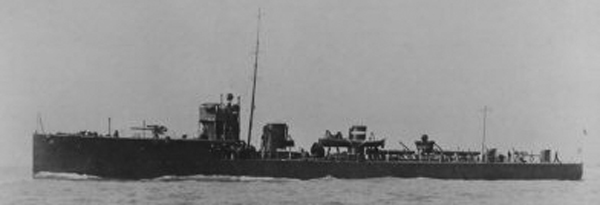
Destroyer HMS Tigress, similar to Lizard, Acheron class
Both monitors also tried to evade fire but in vain. Raglan was soon squared and badly hit, her foretop and range finder destroyed, officers killed. The monitor tried to return fire with but missed and eventually her main armament was knocked out of action by a well-placed shell in the casemate, setting the ammunition on fire (soon drawned by a safety valve). The monitor was hit several more times in her magazines and through the hull, causing the ship to sink. HMS M28 was hit in turn amidships, set ablaze and later sunk after a magazine explosion. It was 6:00 a.m. The battle had lasted for 30 minutes. Meanwhile both destroyers were fast enough to escape the Midilli. With their mission accomplished both ships headed south to raid the allied naval base at Mudros.
Raid attempt at Mudros
Just leaving Kusu Bay, the two ships crossed a minefield, with the two British destroyers on their heals while several British and Greek aircraft had taken off Mudros and tried to strafe the ships. One of the pilots was famous Greek ace Aristeidis Moraitinis, which downed several Turkish aircrafts this day, but the naval aviation had to deal with the rock-solid heavy anti-aircraft armament of the Midilli. The latter however struck a mine near her aft funnel, followed by Yavûz Sultân Selîm. trying to escape, Midilli struck four more mines and sank. The battleships moved to rescue her crew but struck another mine en route and was forced to withdraw to the Dardanelles, closely followed by the Lizard and Tigress at a safe distance.
Soon informed of the situation, the Turkish Ottoman admiralty dispatched four destroyers and a cruiser to repel the British destroyers, hitting the leading ship badly, and forcing thel to retreat. The destroyers then came back to the Dardanelles at Cape Helles only to be greeted by heavy Ottoman shore battery fire. Both ships decided to withdrew back to Imbros. But the battle was not over yet.
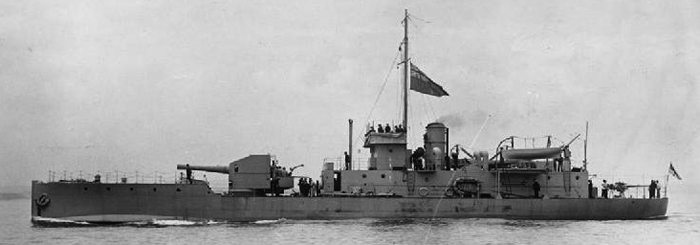
Coastal Monitor HMS M28
HMS Ark Royal deployed its aircraft in an attempt to destoy the Yavuz, still not in safety. A dozen British seaplanes scored two hits on the battlecruiser near the coast. But they were eventually repelled by a resolute attack from ten Ottoman seaplanes combined with heavy anti-aircraft fire. One Sopwith Baby was lost and another damaged. The four Ottoman destroyers also now provided an additionan escort. However the Yavuz at this point was badly damaged and she she ran aground on a sandbar off Nagara Point.
Six days would follow with more allied air attacks, registering six more hits. However these 65-pound (29 kg) bombs were just a pinprick for her heavily armored decks. A submarine was planned to depart to finish her off, but only the HMS E12 which could have been available on paper was stuck by mechanical problems.
Aftermath
On paper, the Turkish attack was an easy win. Only because on unregistered minefield the operation could have seen Imbros and Mudros eliminated with relative impunity. Success was paid by the loss of the most modern ottoman cruiser, Midilli, and the Yavuz was out of action until the end of the war. The ship was left stranded in the sandbar until 26 January when the battleship Turgut Reis towed her back into the Black Sea.
At last, HMS E14 entered the Dardanelles on 27 January, just missing the Ottoman battecruiser. The submersible had to retreat, and en route met but near-missed an Ottoman freighter on her way back with her first torpedo. Her second torpedo exploded prematurely, badly damaging the submarine. She tried to escape, only to met heavy fire from Ottoman shore batteries, and was beached and the whole crew captured. Captain White died in the action but was posthumously awarded the VC.
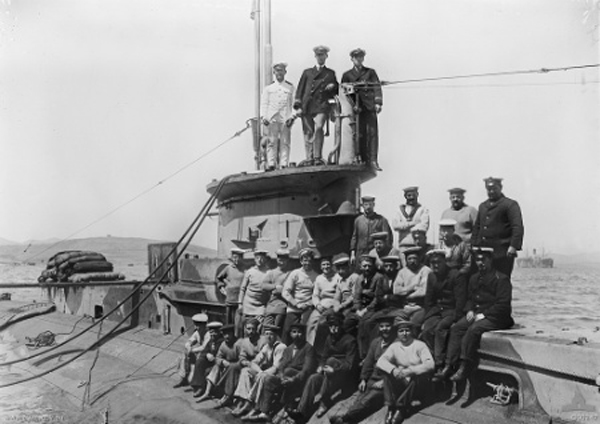
HMS E14 crew posing in 1915 – AWM
Ater the battle, on the strategic level, the threat posed by the Ottoman Navy no longer existed. Nevertheless in the press, the loss of the two monitors and absence of battleship nearby was wildly criticized by the commanders of the British Aegean Squadron. Two pre-dreanought battleships, not useful in the home fleet anyway, could have not only dissuaded the Turkish ships, but also sink them. No praise was given however to the team responsible for the minefield…
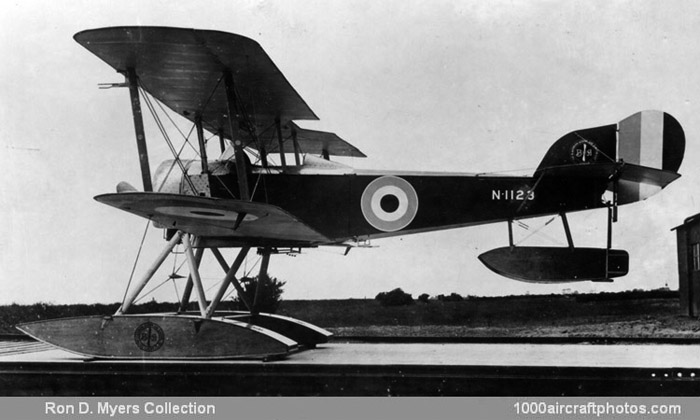
Read More
historynet.com attack over the dardanelles and the role played by naval aviation
timesmachine.nytimes.com the loss of the raglan, press release (pdf)
The Battle of Imbros
Conway’s all the world’s fighting ships 1906-1921

 Latest Facebook Entry -
Latest Facebook Entry -  X(Tweeter) Naval Encyclopedia's deck archive
X(Tweeter) Naval Encyclopedia's deck archive Instagram (@navalencyc)
Instagram (@navalencyc)





 French Navy
French Navy Royal Navy
Royal Navy Russian Navy
Russian Navy Armada Espanola
Armada Espanola Austrian Navy
Austrian Navy K.u.K. Kriegsmarine
K.u.K. Kriegsmarine Dansk Marine
Dansk Marine Nautiko Hellenon
Nautiko Hellenon Koninklije Marine 1870
Koninklije Marine 1870 Marinha do Brasil
Marinha do Brasil Osmanlı Donanması
Osmanlı Donanması Marina Do Peru
Marina Do Peru Marinha do Portugal
Marinha do Portugal Regia Marina 1870
Regia Marina 1870 Nihhon Kaigun 1870
Nihhon Kaigun 1870 Preußische Marine 1870
Preußische Marine 1870 Russkiy Flot 1870
Russkiy Flot 1870 Svenska marinen
Svenska marinen Søværnet
Søværnet Union Navy
Union Navy Confederate Navy
Confederate Navy Armada de Argentina
Armada de Argentina Imperial Chinese Navy
Imperial Chinese Navy Marinha do Portugal
Marinha do Portugal Mexico
Mexico Kaiserliche Marine
Kaiserliche Marine 1898 US Navy
1898 US Navy Sovietskiy Flot
Sovietskiy Flot Royal Canadian Navy
Royal Canadian Navy Royal Australian Navy
Royal Australian Navy RNZN Fleet
RNZN Fleet Chinese Navy 1937
Chinese Navy 1937 Kriegsmarine
Kriegsmarine Chilean Navy
Chilean Navy Danish Navy
Danish Navy Finnish Navy
Finnish Navy Hellenic Navy
Hellenic Navy Polish Navy
Polish Navy Romanian Navy
Romanian Navy Turkish Navy
Turkish Navy Royal Yugoslav Navy
Royal Yugoslav Navy Royal Thai Navy
Royal Thai Navy Minor Navies
Minor Navies Albania
Albania Austria
Austria Belgium
Belgium Columbia
Columbia Costa Rica
Costa Rica Cuba
Cuba Czechoslovakia
Czechoslovakia Dominican Republic
Dominican Republic Haiti
Haiti Hungary
Hungary Honduras
Honduras Estonia
Estonia Iceland
Iceland Eire
Eire Equador
Equador Iran
Iran Iraq
Iraq Latvia
Latvia Liberia
Liberia Lithuania
Lithuania Mandchukuo
Mandchukuo Morocco
Morocco Nicaragua
Nicaragua Persia
Persia San Salvador
San Salvador Sarawak
Sarawak Uruguay
Uruguay Venezuela
Venezuela Zanzibar
Zanzibar Warsaw Pact Navies
Warsaw Pact Navies Bulgaria
Bulgaria Hungary
Hungary

 Bundesmarine
Bundesmarine Dutch Navy
Dutch Navy Hellenic Navy
Hellenic Navy Marina Militare
Marina Militare Yugoslav Navy
Yugoslav Navy Chinese Navy
Chinese Navy Indian Navy
Indian Navy Indonesian Navy
Indonesian Navy JMSDF
JMSDF North Korean Navy
North Korean Navy Pakistani Navy
Pakistani Navy Philippines Navy
Philippines Navy ROKN
ROKN Rep. of Singapore Navy
Rep. of Singapore Navy Taiwanese Navy
Taiwanese Navy IDF Navy
IDF Navy Saudi Navy
Saudi Navy Royal New Zealand Navy
Royal New Zealand Navy Egyptian Navy
Egyptian Navy South African Navy
South African Navy






























 Ukrainian Navy
Ukrainian Navy dbodesign
dbodesign
I own the aneroid barometer which I presume was on board the M 28 .
It is marked M 28 with the arrow
Could be a Model 1928 barometer as well…
My Great Uncle, Harry Moran, was killed on Monitor 28